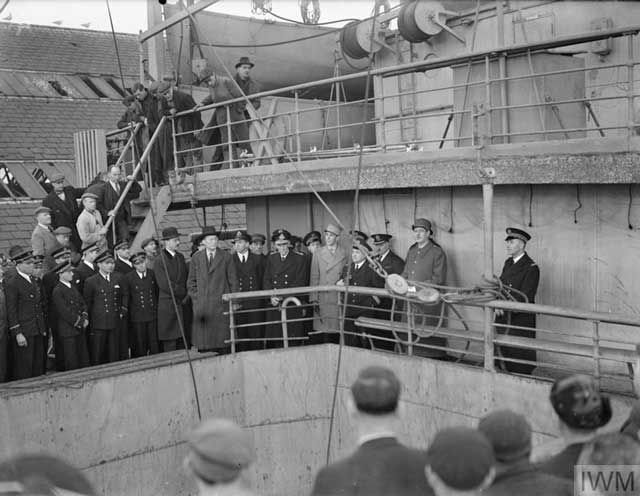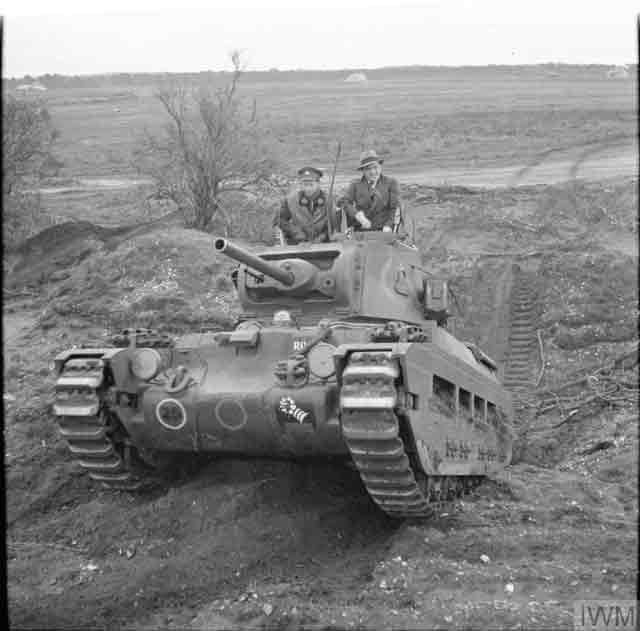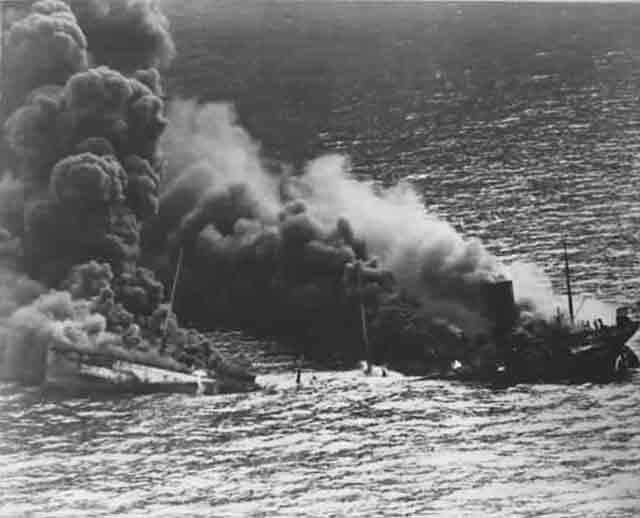Monday 22 December 1941
 |
| "Italian troops surrendering to a patrol of the Polish Independent Carpathian Rifles Brigade on the road south-west of Gazala, Libya, 22 December 1941. One of the prisoners even brought his bicycle with him." © IWM (E 7301). |
Battle of the Pacific: In the Philippines, the Japanese make their main landings on the east coast of Lingayen Gulf during the morning of
22 December 1941. The Japanese have 43,110 troops of the 48th Division and a regiment of the 16th Division, supported by about 90 light tanks and artillery. US commander General Wainwright sends the 11th and 71st Filipino Divisions in a futile counterattack. The Japanese win a brief battle at the coastal town of Rosario against the 26th Cavalry Division of the Filipino Army, which withdraws south toward Manila. Offshore, US submarine USS S-38, sailing out of Manila, torpedoes 5445-ton Japanese transport Hayo Maru. The transport quickly sinks in the Lingayen Gulf. This is S-38's first war patrol and the first US submarine success of the war.
 |
| Life Magazine's 22 December 1941 issue provides a guide to telling Japanese and Chinese citizens apart. |
A US Navy relief operation to Wake Island was organized by Admiral Husband Kimmel before his dismissal. On 22 December 1941 Task Force 14 (Admiral Wilson Brown), supported by Task Force 14 (Admiral Frank Fletcher) is approaching the beleaguered US Marines there. However, at 21:00, the acting commander in chief of the US Pacific Fleet, Vice Admiral William S. Pye, recalls Task Force 11. He bases this on reconnaissance that reveals the presence of two Japanese aircraft carriers and two battleships around the island. While there aren't any battleships, there definitely are two modern aircraft carriers, but the real opponent at this stage of the war is simply the unknown. The Americans don't know where all the Japanese carriers that attacked Pearl Harbor went, and the remaining US carriers are too precious to risk with naval forces so vastly reduced by the attack on Pearl Harbor. Pye instead plans on sending F2A Brewster Buffaloes from USS Saratoga at extreme range to land on the island on the 23rd, supported by a quick run to the island by seaplane tender USS Tangier. However, it is unclear how long the island can hold out against vastly superior Japanese forces.
On Wake Island itself, the US Marines suffer from two Japanese raids launched from carriers Hiryu and Soryu. There are only two operational USMC F4F Wildcats left on the island, and one is shot down and the other badly damaged.
 |
| "Japan's Aggressor, Admiral Yamamoto" is the cover story for the 22 December 1941 Time Magazine. The cover portrait by Arthur Szyk shows Yamamoto as vaguely human but definitely menacing. |
On the Malay Peninsula, fierce air battles develop over Kuala Lumpur. Sergeant Malcolm Neville Read of RAAF No. 453 Squadron rams his Brewster Buffalo fighter into a Nakajima Ki-43 "Oscar" fighter of 64th Sentai and perishes. The Indian 11th Division continues its retreat behind the Perak River, while the Indian 9th Division establishes a strong position around Kuantan airfield that also protects the east flank of the 11th Division.
The situation in Burma is deteriorating rapidly, with Japanese forces making good progress in the extreme south. Generalissimo Chiang Kai-shek realizes that his best supply route runs through Burma, so he gives General Archibald Wavell, Commander-in-Chief, India, ground forces. He sends the Chinese 6th Army's 93rd Division and a regiment of the 49th Division, with the promise of more to come. The American Volunteer Group (AVG, aka "Flying Tigers") are operating east of Rangoon, but there is a serious lack of Allied ground troops in the country which Chiang can remedy faster than the British.
 |
| USAT Willard H. Holbrook arrives in Brisbane, Australia, 22 December 1941. It is part of the United States Navy's "Pensacola" Convoy that includes heavy cruiser USS Pensacola, gunboat Niagara, naval transports Chaumont and Republic, Army transports Holbrook and Meigs, and three freighters. They carry the first US troop units to arrive in Australia from the United States. |
A Japanese convoy leaves Miri, Borneo for Kuching. A Dutch flying boat X-35 radios a warning to HNLMS K XIV (Lt. Cdr. Carel A.J. van Groeneveld), which heads to intercept it on the 23rd.
 |
| Newsweek, 22 December 1941, features Navy dive bombers. |
About 15 nautical miles off the coast of California southwest of Lompoc, Japanese submarine I-19 uses its deck gun against 10,763-ton American tanker H.M. Storey. The recent spate of Japanese submarine attacks off the coast has attracted a great deal of attention, and a US Navy aircraft swiftly arrives and drops a depth charge. This provides enough of a distraction for the tanker to escape.
 |
| "A 25-pdr field gun and 'Quad' artillery tractor, 22 December 1941" North Africa. (© IWM (E 7245)). |
Battle of the Mediterranean: In North Africa, the British Commonwealth forces continue pressing against the Afrika Corps, which has retreated to Beda Fomm and now is evacuating from Benghazi. The Germans have received some reinforcements from Tripoli and manage to stop the British by deploying 30 panzers. General Erwin Rommel, commander of Panzer Group Africa, sends a battle report to German General Headquarters in Rome for translation to Mussolini which notes "the extraordinarily strong enemy air superiority."
 |
| "Universal carrier of 40th Royal Tank Regiment, 8th Armoured Division being recovered from a hole at Warren Camp, Crowborough in Sussex, 22 December 1941. The regiment was about to embark for the Middle East, hence the desert camouflage." © IWM (H 16283). |
Eastern Front: Having taken a somewhat leisurely drive from his former headquarters in Smolensk to East Prussia, Field Marshal Fedor von Bock arrives at the Fuhrer Headquarters in Rastenburg. After a brief visit with Hitler, during which the Fuehrer assures him that he understands the dire situation at the front, von Bock continues on to Berlin. It is an odd interlude because von Bock is not actually sick, but Hitler tells him to report back when he is "recovered."
 |
| Four Polikarpov I-15 biplanes ("Chaika," or seagull) under repair in Moscow, 22 Dec 1941. |
At the front around Moscow, things are not quite so pleasant. In a driving snowstorm, Soviet 49th Army attacks at Tarusa and scores a quick breakthrough against the German Fourth Army. This separates the German 43rd Corps from the rest of the army and sets up a possible encirclement. The Army Group commander, Field Marshal Guenther von Kluge, follows standing orders and tells the corps to stand fast. However, von Kluge warns Fuehrer Headquarters of the danger. At Chekalin, Soviet sled troops surprise a German construction unit, which cannot be reinforced because of the snow and push it back. General Guderian spends the day at the front south of Moscow and is dismayed. He finds that the Soviets have broken through 296th Infantry Division at several points. He also warns Fuehrer Headquarters that he will lose the division entirely if it is required to hold its position.
 |
| President Roosevelt and Winston Churchill in Washington, D.C., 22 December 1941. |
US/British Relations: The Arcadia Conference ("Arcadia" being the official code name for it), also known as the First Washington Conference, begins in Washington, D.C. on 22 December 1941. This is a meeting of top British and United States political and military leaders. Winston Churchill makes the hazardous ten-day journey across the Atlantic in battleship HMS Duke of York. This is the first of many military conferences between the two powers while both are at war. The conference lasts until 14 January 1942 and establishes the defeat of Germany as the top priority of the alliance. This comports with the established US military Rainbow 5 plan which already is in effect. Other agreements reached at the Arcadia Conference include establishing a Combined Chiefs of Staff, based in Washington, limiting resources to be sent to the Pacific Theater, and a "Declaration by United Nations" which establishes the principle of no separate peace with the Axis. The Arcadia Conference projects the first combined offensive action by the two powers as an invasion of North Africa, creates a unified American/British/Dutch/Australian Command (ABDA) in the Far East and establishes that military resources will be combined for the common benefit in the European Theater of Operations (ETO).
 |
| "Western Desert, Libya. 22 December 1941. The fierce attacks upon enemy aerodromes by the Allied Air Forces destroyed many aircraft which never had a chance of taking the air." Australian War Memorial MED0221. |
December 1941December 1, 1941: Hitler Fires von RundstedtDecember 2, 1941: Climb Mount NiitakaDecember 3, 1941: Hints of Trouble in the PacificDecember 4, 1941: Soviets Plan CounteroffensiveDecember 5, 1941: Soviets Counterattack at KalininDecember 6, 1941: Soviet Counterattack at Moscow BroadensDecember 7, 1941: Japan Attacks Pearl HarborDecember 8, 1941: US Enters World War IIDecember 9, 1941: German Retreat At MoscowDecember 10, 1941: HMS Prince of Wales and Repulse SunkDecember 11, 1941: Hitler Declares War on USDecember 12, 1941: Japanese in BurmaDecember 13, 1941: Battle of Cape BonDecember 14, 1941: Hitler Forbids WithdrawalsDecember 15, 1941: The Liepaja MassacreDecember 16, 1941: Japan Invades BorneoDecember 17, 1941: US Military ShakeupDecember 18, 1941: Hitler Lays Down the LawDecember 19, 1941: Brauchitsch Goes HomeDecember 20, 1941: Flying Tigers in ActionDecember 21, 1941: The Bogdanovka MassacreDecember 22, 1941: Major Japanese Landings North of ManilaDecember 23, 1941: Wake Island Falls to JapanDecember 24, 1941: Atrocities in Hong KongDecember 25, 1941: Japan Takes Hong KongDecember 26, 1941: Soviets Land in the CrimeaDecember 27, 1941: Commandos Raid NorwayDecember 28, 1941: Operation Anthropoid BeginsDecember 29, 1941: Soviet Landings at FeodosiaDecember 30, 1941: Race for BataanDecember 31, 1941: Nimitz in Charge2020



































